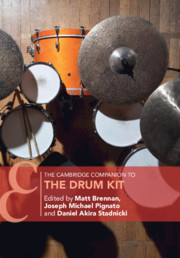Book contents
- The Cambridge Companion to the Drum Kit
- Cambridge Companions to Music
- The Cambridge Companion to the Drum Kit
- Copyright page
- Contents
- Figures
- Tables
- Music Examples
- Notes on Contributors
- Introduction
- Part I Histories of the Drum Kit
- Part II Analysing the Drum Kit in Performance
- Part III Learning, Teaching, and Leading on the Drum Kit
- 10 Studying Hybrid and Electronic Drum Kit Technologies
- 11 The Aesthetics of Timekeeping
- 12 Mentorship
- 13 Leadership
- Part IV Drumming Bodies, Meaning, and Identity
- Index
13 - Leadership
The View from behind the Kit
from Part III - Learning, Teaching, and Leading on the Drum Kit
Published online by Cambridge University Press: 28 May 2021
- The Cambridge Companion to the Drum Kit
- Cambridge Companions to Music
- The Cambridge Companion to the Drum Kit
- Copyright page
- Contents
- Figures
- Tables
- Music Examples
- Notes on Contributors
- Introduction
- Part I Histories of the Drum Kit
- Part II Analysing the Drum Kit in Performance
- Part III Learning, Teaching, and Leading on the Drum Kit
- 10 Studying Hybrid and Electronic Drum Kit Technologies
- 11 The Aesthetics of Timekeeping
- 12 Mentorship
- 13 Leadership
- Part IV Drumming Bodies, Meaning, and Identity
- Index
Summary
Music leadership is a foggy notion with many meanings. Leaders may be chosen, unchosen, appointed, unappointed, or self-appointed. As a powerful dimension of collaborative performance, leadership is framed here first as a linear-hierarchical model– a ‘one-way street’; second, as a visionary-transformational model – a ‘two-way street’; and third, as a plural-distributed model – a ‘shared street’. All three are examined in the light of Leader-Member Exchange theory of leadership (LMX). The extent to which the leader and subordinate exchange resources and support beyond what is expected based on the formal employment contract evidences a high LMX. A low LMX relationship is one in which the employee performs within the bounds of the employment contract but contributes nothing extra. Nine musicians, selected for their many years of experience in giving, receiving, and sharing leadership functions, provided interview data. Analysis generated a number of different elements that were identified as having a reported impact on music decision making. This chapter uses those elements to contribute to a growing body of knowledge of use to the drummer in her development of a suite of 'off-instrument' skills now seen as every bit important as her suite of 'on-instrument' ones.
- Type
- Chapter
- Information
- The Cambridge Companion to the Drum Kit , pp. 181 - 194Publisher: Cambridge University PressPrint publication year: 2021

